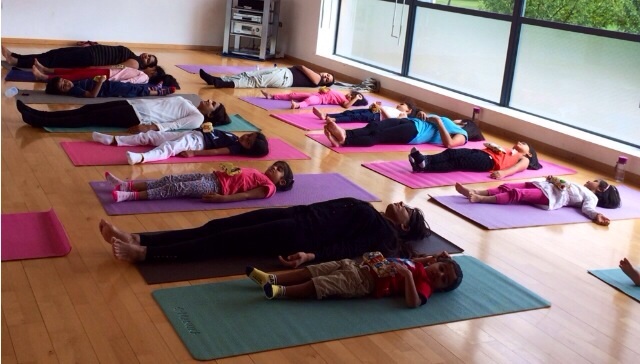|
Shavasana or the corpse pose is a relaxation pose when deep healing can take place. This pose gets its name from the recumbent posture of a dead body.
This asana relaxes the entire psycho-physiological system and should ideally be practiced before sleep; during and after the practice of yoga asanas, particularly after dynamic exercises such as Surya Namaskar or the Sun Salutation; and when one feels physically and mentally tired. It develops a sense of body awareness. Shavasana is perhaps the most important part of yoga practice. Lying on the back, the arms and legs are spread at about 45 degrees, the eyes are closed and the breath deep, using deergha (long) pranayama. The whole body is relaxed onto the floor with an awareness of the chest and abdomen rising and falling with each breath. All parts of the body are scanned for muscular tension of any kind, which is consciously released as it is found, optionally with a small repetitive movement of the area. All control of the breath, the mind, and the body is then released for the duration of the asana. The asana is released by slowly deepening the breath, flexing the fingers and toes, reaching the arms above the head, stretching the whole body, exhaling, bringing the knees to the chest and rolling over to the side in a fetal position. After a short time and a slow inhalation, the practitioner takes a seated position. Children need rest and rejuvenation as much as adults and probably more. I use a story and a calm, peaceful voice to get the children to relax and slowly bring their minds and bodies to rest. Children benefit from this deep rest not only at the end of yoga class but also throughout their day. Benefits: Shavasana gives the nervous system a chance to integrate that in what can be thought of as a brief pause before it is forced once again to deal with all the usual stresses of daily life. Shavasana decreases heart rate, blood pressure, muscle tension and general levels of anxiety. It increases energy levels, boosts memory and stimulates the ability to concentrate. Shavasana also serves the point of ritual. It gives teachers the opportunity to guide students in relaxation, self-blessing, prayer, affirmation or simple, extraordinary peace. It allows the individual practitioner to give ceremony and sacredness to their yoga practice and to feel “the sweet spot” that so often results from our efforts in yoga. A tip when doing Shavasana… Do not rush it. Take your time. Allow the body to heal itself slowly. Shavasana ideally should be done for around 20-30 minutes so give yourself that time, and remember it is an integral part of yoga; a chance to connect the physical to the spiritual.
0 Comments
Leave a Reply. |
News & VideosHello. This is where we will be posting regular updates, videos, articles and tips. Categories
All
|

 RSS Feed
RSS Feed